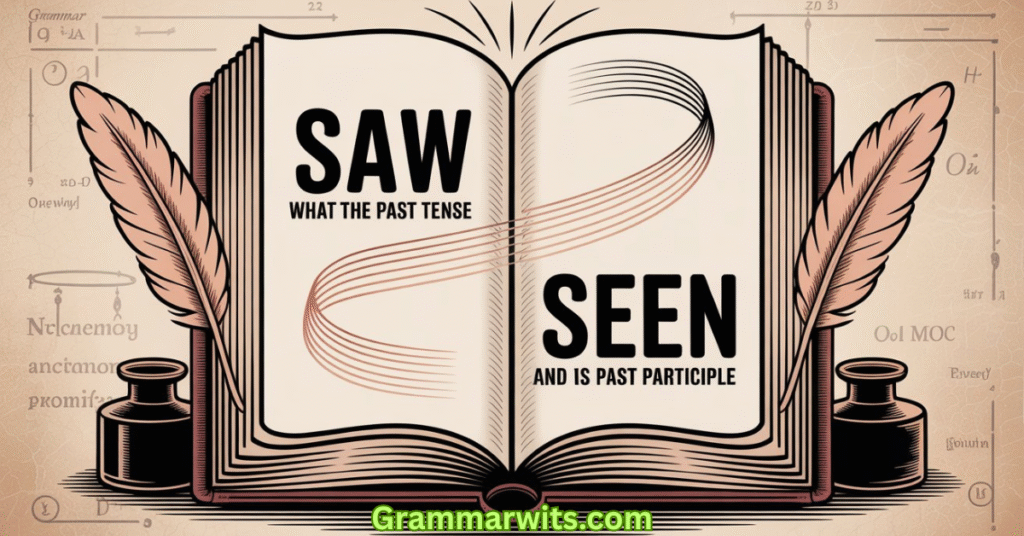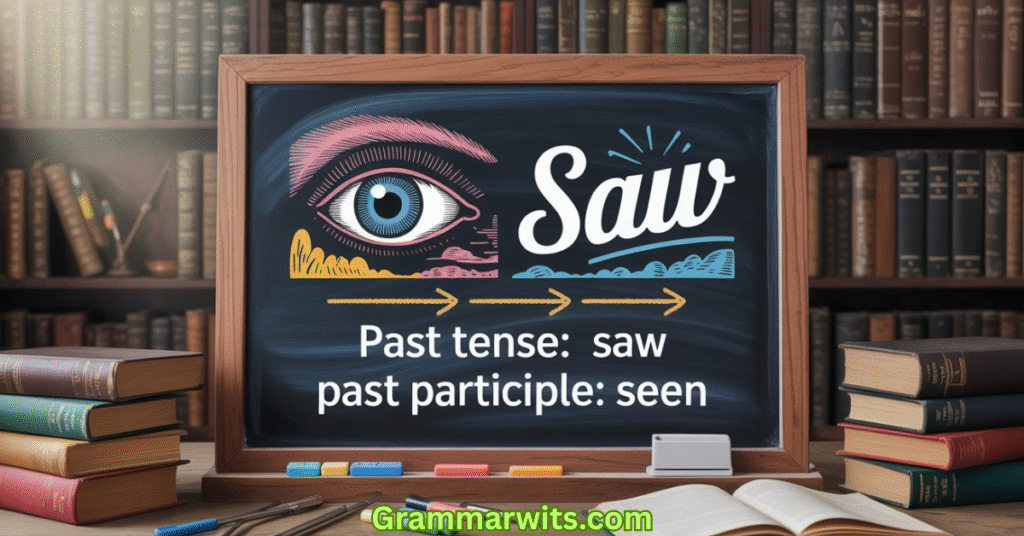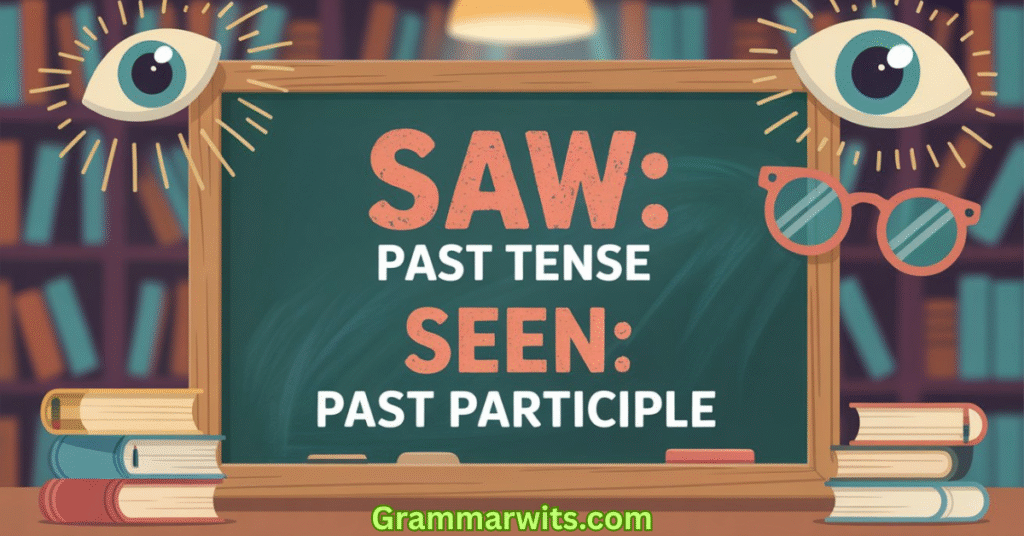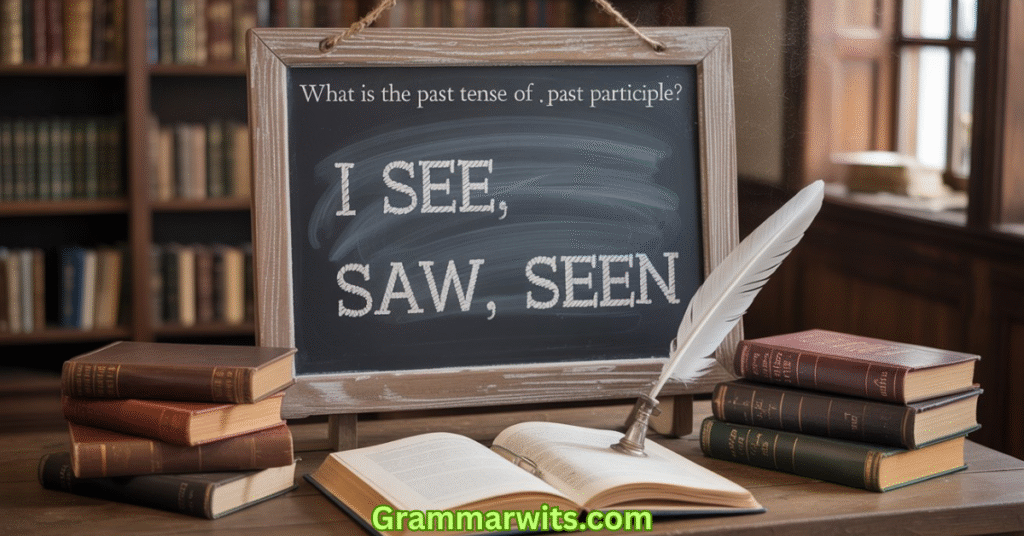In English grammar, past tense refers to the form of a verb used to describe actions that have already happened. The past participle is another verb form often used with auxiliary verbs like have, has, or had to create perfect tenses. While both forms refer to past actions, they serve different grammatical roles. Understanding these verb changes is essential for forming accurate and meaningful sentences, especially when dealing with irregular verbs like see.
Everyday conversation, storytelling, and writing rely on choosing the correct verb forms. Mixing up saw and seen might seem small, but it can make sentences sound awkward or incorrect. Mastering these grammar points adds clarity to your speech and polish to your writing. Whether you’re a student, writer, or ESL learner, knowing how see changes in tense helps you communicate with confidence and fluency.
The past tense isn’t just a grammar rule—it brings your stories to life. It allows you to reflect, describe events, and create vivid timelines. By using the past tense correctly, you show the exact moment something occurred, making your message stronger and clearer.
Understanding the Verb “See” – Base Form Breakdown
The English verb “see” belongs to a challenging category called irregular verbs in English. Unlike regular verbs that simply add “-ed” for past tense, “see” follows its own unique pattern that doesn’t follow standard grammatical rules.
Here’s the complete conjugation pattern:
| Verb Form | Example |
|---|---|
| Base Form | See |
| Past Tense | Saw |
| Past Participle | Seen |
| Present Participle | Seeing |
Why irregular verbs exist stems from historical language learning evolution. Old English contained hundreds of strong verbs that changed their internal vowels rather than adding suffixes. The verb “see” survived this linguistic transformation, maintaining its irregular nature.
Memory hook: “I see now, I saw then, I have seen before.” This simple phrase captures all three primary forms you’ll need for tense consistency in your writing and speaking.
Past Tense of “See” – Deep Dive

The Simple Answer: “Saw”
The past tense of “see” is “saw” – no exceptions, no variations. This verb transformation doesn’t follow the typical “-ed” pattern that regular verbs use. When describing completed actions in the past, “saw” becomes your go-to choice.
Past tense examples that demonstrate correct form of see:
- “She saw the accident yesterday”
- “We saw three movies last weekend”
- “The detective saw crucial evidence at the scene”
When to Use Past Tense
Past tense serves specific grammatical functions in English grammar. You’ll use “saw” when describing:
Specific past moments: Actions tied to definite timeframes like yesterday, last week, or in 2020 require past sentence. Storytelling in past tense relies heavily on this form to establish clear timelines.
Story telling: Sequential past events flow naturally with past sentence construction. “First, I saw the problem. Then, I saw the solution.”
Completed actions: Events finished in the past with no connection to the present moment call for past tense. The action of seeing ended at a specific point in history.
Regional Variations and Dialects
The “I seen” phenomenon appears in certain dialects but isn’t considered standard English grammar. This common usage error stems from confusion between past tense and past participle forms.
Geographic patterns show non-standard forms appearing more frequently in informal speech across various regions. However, professional and academic writing demands adherence to standard grammatical rules.
Professional vs. casual settings determine when precision matters most. Grammar mistakes in business communication can undermine credibility and professional image.
Past Participle of “See” – Complete Guide
The Form: “Seen”
The past participle of “see” is “seen” – and it always needs helping verbs like have, has, had, or been. This verb conjugation rule prevents the notorious “seen” without helper mistake that plagues many speakers.
Perfect sentence constructions rely on past participle forms:
- Present perfect: “I have seen that show”
- Past perfect: “She had seen it before we arrived”
- Future perfect: “By tonight, we will have seen all episodes”
Perfect Tense Applications
Present tense vs past tense distinctions become crucial when selecting between past participle and simple past sentence. Present perfect sentence using “seen” indicates experience or actions with present relevance.
Past perfect tense establishes sequence relationships between past events. “She had seen the movie before the book came out” shows temporal ordering through past participle usage.
Future perfect tense projects completed actions into future contexts. Sentence consistency demands careful attention to these subtle but important distinctions.
Passive Voice Usage
Passive voice construction transforms “seen” into a different grammatical role. “The movie was seen by millions” shifts focus from the viewer to the action itself.
When the action matters more than the doer, passive voice provides elegant solutions. News reporting frequently employs this structure: “The suspect was seen leaving the area.”
Formal writing applications often benefit from passive voice constructions using past participle forms like “seen.”
Grammar Traps and How to Dodge Them

The “Seen” Without Helper Trap
This represents the most common grammar mistake involving “see” verb forms. The error occurs when speakers use past participle without required auxiliary verbs.
Wrong examples:
- “I seen the game” ❌
- “We seen that before” ❌
Correct alternatives:
- “I saw the game” ✅ (past tense)
- “I have seen the game” ✅ (past participle with helper)
Quick test: Can you naturally add “have” to the sentence? If yes, you need past participle. If no, use past sentence.
Mixing Up Timeline References
Present perfect vs simple past confusion creates tense correction challenges. Sentence examples illustrate these distinctions:
“Ever” and “never” signal present perfect tense requirements:
- “Have you ever seen this movie?” ✅
- “Did you ever saw this movie?” ❌
Specific time markers demand simple past tense:
- “I saw it yesterday” ✅
- “I have seen it yesterday” ❌
Double Past Mistakes
Avoiding combinations like “I had saw” prevents embarrassing grammar mistakes. This error combines past tense with past perfect auxiliary verbs incorrectly.
Correct forms maintain consistency:
- “I had seen” ✅ (past perfect)
- “I saw” ✅ (simple past sentence)
Real-World Applications and Examples
Professional Communication
Email writing demands precision in verb selection. “I saw your message” indicates past sentence completion, while “I have seen the report” suggests ongoing relevance through present perfect construction.
Meeting language requires careful consistency to maintain professional credibility. Grammar tips for business communication emphasize clarity over complexity.
Customer service interactions benefit from clear timeline communication using appropriate past tense or past participle forms.
Academic and Formal Writing
Research citations often employ present perfect tense: “Studies have seen improvements in patient outcomes.” This past participle usage connects past research to current understanding.
Literature analysis distinguishes between past events within texts and ongoing relevance to contemporary readers. Past tense describes plot events, while present perfect connects themes to modern contexts.
Report writing maintains tense consistency throughout documents, avoiding jarring shifts between past tense and past participle constructions.
Quick Reference Tools
Conjugation Chart
| Tense | Positive | Negative | Question |
|---|---|---|---|
| Present | I see | I don’t see | Do I see? |
| Past Tense | I saw | I didn’t see | Did I see? |
| Present Perfect | I have seen | I haven’t seen | Have I seen? |
| Past Perfect | I had seen | I hadn’t seen | Had I seen? |
Decision Tree for Verb Tense Selection
1: Is the action completed in the past with a specific time?
- Yes → Use past tense (“saw”)
- No → Continue to Step 2
2: Does the past action connect to the present?
- Yes → Use present perfect (“have seen”)
- No → Use past tense (“saw”)
3: Are you describing sequence in the past?
- Yes → Consider past perfect (“had seen”)
- No → Stick with simple past (“saw”)
Common Usage Errors and Corrections

Grammar mistakes with “see” past tense appear frequently in both speech and writing. Here are the most problematic common usage errors:
1-Error: “I seen him at the store” Correction: “I saw him at the store” (past tense)
2–Error: “We was seen the movie”
Correction: “We saw the movie” (past tense) or “We were seen watching the movie” (passive voice)
3-Error: “Have you saw this before?” Correction: “Have you seen this before?” (past participle)
Tense correction strategies include reading sentences aloud and checking for helper verb requirements with past participle forms.
Conclusion and Key Takeaways
Mastering the past tense of “see” and its past participle requires understanding three essential forms: see, saw, and seen. Past tense “saw” handles completed past actions, while past participle “seen” needs helper verbs for perfect tenses and passive voice.
Grammar rules for irregular verbs like “see” demand memorization rather than pattern recognition. Practice these verb forms in context through sentence examples and real-world applications.
Confidence building comes through consistent practice and awareness of common grammar mistakes. Remember: “saw” stands alone, “seen” needs help, and tense consistency matters in professional communication.
FAQ Section
What’s the difference between “I saw” and “I have seen”? “I saw” describes a completed past tense action at a specific time. “I have seen” uses present perfect tense to show experience or ongoing relevance to the present moment.
Is “I seen” ever correct in English? “I seen” is never correct in standard English grammar. You need either “I saw” (past tense) or “I have seen” (past participle with helper verb).
When do I use “seen” in passive voice? Use “seen” in passive voice when the action matters more than the actor: “The suspect was seen leaving” or “Improvements were seen in test scores.”
How do I remember irregular verb forms like “see”? Create memory hooks like “I see now, I saw then, I have seen before.” Practice conjugation patterns through repetition and context-based sentence examples.
What are the most common mistakes with “see” in professional writing? The biggest grammar mistakes include using “seen” without helper verbs, mixing up past sentence and past participle forms, and inconsistent verb tense throughout documents. Always proofread for sentence consistency.

Alizy Smith is a passionate language enthusiast and the admin of Grammar Wits. With a love for wordplay, grammar quirks, and witty expressions, she’s dedicated to making language learning fun and accessible. From grammar tips to pun-filled laughs, Alizy ensures every piece of content entertains while educating — turning tricky rules into easy, enjoyable reads.
